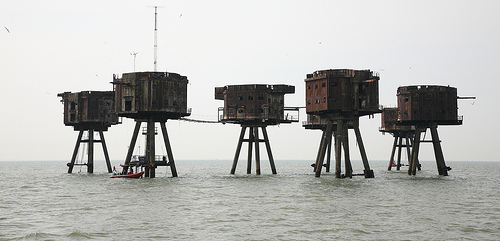Imagine living out in the isolated sea on the Maunsell Forts.
- Maunsell Forts are a group of buildings that were erected in the ocean for the defence of the United Kingdom, in Europe, near the mouths of the River Thames and the River Mersey.
- Maunsell Forts were built for use in World War II, serving as forts for either the navy or the army, depending on the fort, with the army forts consisting of a set of seven connected towers.
- Four navy forts and three army forts were built in the Thames estuary as part of the Maunsell Fort system, named ‘Rough Sands’, ‘Sunk Head’, ‘Tongue Sands’, ‘Knock John’, ‘Nore’, ‘Red Sands’ and ‘Shivering Sands’, numbered U1-U7 respectively, and are collectively known as the ‘Thames Sea Forts’.
- Observing, searching for and halting German aircraft and other threats, during World War II, were the primary uses of the Maunsell Forts.
- The main material used in the construction of Maunsell Forts was concrete and steel, with the navy forts sitting on a flat bed supported by two cylindrical columns, and the army fort towers sitting atop four cylindrical legs that sit like a square pyramid.
Maunsell Sea Forts
Image courtesy of Steve Cadman/Flickr
- Maunsell Forts were designed by engineer Guy Maunsell from Britain, hence their name, and were built in the early 1940s.
- A number of Maunsell Forts or towers have been destroyed since World War II, due to watercraft collisions and weather conditions, while the forts in the Mersey estuary were removed due to the hindrance to ships travelling in the area.
- By the 1950s the Maunsell Forts were no longer used for their original purpose and were mostly left abandoned, however, during the 1960s, a number of the forts were overtaken by pirates as a base to broadcast pirate radio.
- Many of the remaining Maunsell Forts are in a state of deterioration and they can be quite hazardous to approach, so viewing is generally performed from a distance.
- Restoring the Maunsell Forts has been considered, and a preservation project, known as Project Redsand began in 2003 to restore the Red Sand towers so that they could be used commercially for communications, recording of music, experiments, and history related activities.
Bibliography:
Maunsell Army Sea Forts, 2014, Atlas Obscura, http://www.atlasobscura.com/places/maunsell-army-sea-forts
Maunsell Forts, 2014, Wikipedia, http://en.wikipedia.org/wiki/Maunsell_Forts
World War II: ‘Fort Madness: Britain’s Bizarre Sea Defense Against the Germans, 2010, Spiegel Online International, http://www.spiegel.de/international/zeitgeist/world-war-ii-fort-madness-britain-s-bizarre-sea-defense-against-the-germans-a-728754.html






